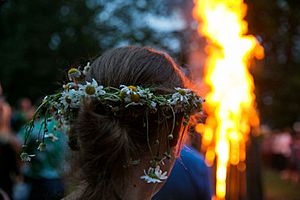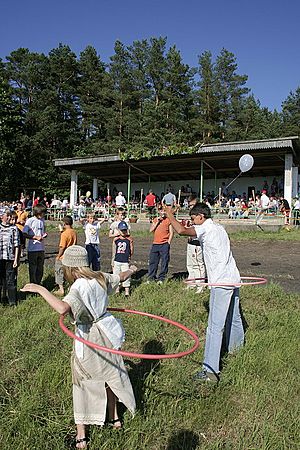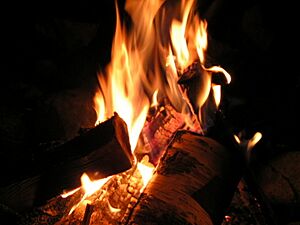Saint Jonas's Festival facts for kids
Saint Jonas' Festival, also known as Rasos (which means Dew Holiday), Joninės, or Kupolė, is a special Lithuanian summer festival. It is celebrated on June 24th across Lithuania and by Lithuanians living all over the world. This festival is a time for fun activities like making flower wreaths, lighting big bonfires, and enjoying music and dancing. It's a joyful way to celebrate the longest day of the year!
What is Saint Jonas' Festival?
Saint Jonas' Festival is a Christian holiday. It is celebrated the night before the Feast Day of Saint John the Baptist. This date is also very close to the summer solstice. The summer solstice is the day when the sun is out for the longest time, and the night is the shortest. Because of this, the festival also has old traditions from pagan times. People sometimes call it Rasos or Kupolė, which means "Feast of the Dews."
During the festival, people often look for a special "magic fern flower." They also have torchlight parades, traditional dances, and music. Big bonfires are a common sight. People also enjoy making beautiful crowns from flowers and herbs.
Some old traditions involve girls decorating a pole called the Kupolė with flowers. They would protect it from young men for a few days. After that, the flowers were shared among the girls. People believed these flowers could protect them from sickness. Sometimes, people jump over the bonfires. Another tradition is lighting a wheel on fire at the top of a tall pole.
The magic fern flower is said to bloom for only one moment at midnight. Finding it is believed to bring good luck. People search for it quietly.
Other traditions focus on dew, which is important for good harvests. People believed that dew on Midsummer night had special powers. They would collect dew and sprinkle it on gardens. They also put it on their faces or used it to bathe sick people.
History and Traditions
The first time Lithuanian Joninės was written about was in 1372. A writer named Hermann von Wartberge mentioned it. He wrote that Lithuanians celebrated the summer solstice with fire and old customs. The Teutonic Knights tried to stop these practices because they thought they were pagan.
For a very long time, water has been important during Joninės. People believed that more dew on the morning of the festival meant a better harvest. They also thought that dew before sunrise had healing powers. On Midsummer night, people collected dew by dragging linen cloth over meadows. They used it for healing. They also washed their faces with it, especially dew from rye fields. They believed it would make their skin brighter. On the evening before or early morning of the festival, people went to rivers or lakes to bathe. They hoped to get well from sickness, become stronger, and avoid diseases. These customs came from old Lithuanian pagan beliefs. The later Christian traditions are about honoring Saint John.
The most important symbols of the festival are the Sun and fire. People thank the Sun for its light and warmth. They ask for its favor. The celebration happens outdoors, around a big bonfire. The bonfire is usually built on the highest spot nearby. Old wheel hubs on long poles and small barrels filled with tar were also burned. People believed that the farther the fire's light reached, the bigger the harvest would be. The fire was started using flint. This fire was thought to be special and could protect against illness and bad luck. People threw weeds into the fire, believing they would be destroyed. Young people sang songs, danced in circles, and jumped over the fire in pairs. It was believed that if a girl and boy jumped over the fire holding hands, they would get married.
Since the 1950s, Joninės customs started to change. On the evening before the celebration, men would bring oak branches. Women would weave these into garlands. They used these garlands to decorate the door or gate of someone named Jonas, Jonė, or Janina. Sometimes, flowers like peonies or jasmines were added to the garlands. In some places, a small gift was hung on the garland or door handle. People tried to deliver their greetings secretly at night. If the person celebrating their name day caught them, tradition said they would offer treats like beer, cheese, and cake.
In the 1960s and 1970s, Joninės festivals began to be organized in places like Rambynas and Kernavė. These events attracted people from all over Lithuania. They included concerts, games, outdoor dances, and the search for the mythical fern blossom. Lithuanians named Jonas, Jonė, or Janina receive many greetings from their family and friends.
Since the 1980s, with the growth of folklore and Romuva movements, Joninės has been celebrated more often using ancient traditions. Since 1987, Joninės has been celebrated in Jonava as the city's name day festival. This helps keep the traditions alive. Since 2004, Joninės has been an official public holiday in Lithuania.
See also
- Kupolė
- Ivan Kupala Day
- Jāņi
- Jaaniõhtu
- Festa de São João do Porto




